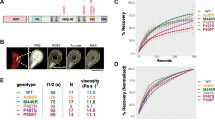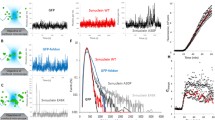Abstract
Protein aggregates are a common feature of nearly all neurodegenerative diseases, including Alzheimer’s disease, Parkinson’s disease, and amyotrophic lateral sclerosis (ALS). Here we describe a method to quickly and accurately measure protein aggregation in cells expressing a fluorescently tagged aggregation-prone protein. This unbiased method obviates the need for manual scoring and facilitates the identification of factors governing protein self-assembly and its downstream consequences for cell heath.
Access this chapter
Tax calculation will be finalised at checkout
Purchases are for personal use only
Similar content being viewed by others
References
Deng H-X, Chen W, Hong S-T et al (2011) Mutations in UBQLN2 cause dominant X-linked juvenile and adult-onset ALS and ALS/dementia. Nature 477(7363):211–215. https://doi.org/10.1038/nature10353
Williams KL, Warraich ST, Yang S et al (2012) UBQLN2/ubiquilin 2 mutation and pathology in familial amyotrophic lateral sclerosis. Neurobiol Aging 33(10):2527.e3–2527.e10. https://doi.org/10.1016/j.neurobiolaging.2012.05.008
Teyssou E, Chartier L, Amador MDM et al (2017) Novel UBQLN2 mutations linked to amyotrophic lateral sclerosis and atypical hereditary spastic paraplegia phenotype through defective HSP70-mediated proteolysis. Neurobiol Aging 58:239.e11–239.e20. https://doi.org/10.1016/j.neurobiolaging.2017.06.018
Gkazi SA, Troakes C, Topp S et al (2019) Striking phenotypic variation in a family with the P506S UBQLN2 mutation including amyotrophic lateral sclerosis, spastic paraplegia, and frontotemporal dementia. Neurobiol Aging 73:229.e5–229.e9. https://doi.org/10.1016/j.neurobiolaging.2018.08.015
Brettschneider J, Van Deerlin VM, Robinson JL et al (2012) Pattern of ubiquilin pathology in ALS and FTLD indicates presence of C9ORF72 hexanucleotide expansion. Acta Neuropathol 123(6):825–839. https://doi.org/10.1007/s00401-012-0970-z
Mori F, Tanji K, Odagiri S et al (2012) Ubiquilin immunoreactivity in cytoplasmic and nuclear inclusions in synucleinopathies, polyglutamine diseases and intranuclear inclusion body disease. Acta Neuropathol 124(1):149–151. https://doi.org/10.1007/s00401-012-0999-z
Safren N, Chang L, Dziki KM et al (2015) Signature changes in ubiquilin expression in the R6/2 mouse model of Huntington’s disease. Brain Res 1597:37–46. https://doi.org/10.1016/j.brainres.2014.12.008
Dao TP, Kolaitis RM, Kim HJ et al (2018) Ubiquitin modulates liquid-liquid phase separation of UBQLN2 via disruption of multivalent interactions. Mol Cell 69(6):965–978.e6. https://doi.org/10.1016/j.molcel.2018.02.004
Dao TP, Martyniak B, Canning AJ et al (2019) ALS-linked mutations affect UBQLN2 Oligomerization and phase separation in a position- and amino acid-dependent manner. Structure 27(6):937–951. https://doi.org/10.1016/J.STR.2019.03.012
Yang Y, Jones HB, Dao T et al (2019) Single amino acid substitutions in stickers, but not spacers, substantially alter UBQLN2 phase transitions and dense phase material properties. J Phys Chem B 123(17):3618–3629. https://doi.org/10.1021/acs.jpcb.9b01024
Sharkey LM, Safren N, Pithadia AS et al (2018) Mutant UBQLN2 promotes toxicity by modulating intrinsic self-assembly. Proc Natl Acad Sci U S A 115(44):E10495–E10504. https://doi.org/10.1073/pnas.1810522115
Higgins N, Lin B, Monteiro MJ (2019) Lou Gehrig’s disease (ALS): UBQLN2 mutations strike out of phase. Structure 27(6):879–881. https://doi.org/10.1016/j.str.2019.05.006
Wang J, Nirujogi RS, Myong S et al (2018) Ubiquilin 2 modulates ALS/FTD-linked FUS–RNA complex dynamics and stress granule formation. Proc Natl Acad Sci U S A 115(49):E11485–E11494. https://doi.org/10.1073/pnas.1811997115
Ramdzan YM, Polling S, Chia CPZ et al (2012) Tracking protein aggregation and mislocalization in cells with flow cytometry. Nat Methods 9(5):467–470. https://doi.org/10.1038/nmeth.1930
Weskamp K, Safren N, Miguez R et al (2019) Monitoring neuronal survival via longitudinal fluorescence microscopy. J Vis Exp 143. https://doi.org/10.3791/59036
Viesselmann C, Ballweg J, Lumbard D et al (2010) Nucleofection and primary culture of embryonic mouse hippocampal and cortical neurons. J Vis Exp 47. https://doi.org/10.3791/2373
Pacifici M, Peruzzi F (2012) Isolation and culture of rat embryonic neural cells: a quick protocol. J Vis Exp 63. https://doi.org/10.3791/3965
Author information
Authors and Affiliations
Corresponding author
Editor information
Editors and Affiliations
Rights and permissions
Copyright information
© 2023 Springer Science+Business Media, LLC, part of Springer Nature
About this protocol
Cite this protocol
Safren, N., Sharkey, L.M., Barmada, S.J. (2023). Neuronal Puncta/Aggregate Formation by WT and Mutant UBQLN2. In: Cieplak, A.S. (eds) Protein Aggregation. Methods in Molecular Biology, vol 2551. Humana, New York, NY. https://doi.org/10.1007/978-1-0716-2597-2_34
Download citation
DOI: https://doi.org/10.1007/978-1-0716-2597-2_34
Published:
Publisher Name: Humana, New York, NY
Print ISBN: 978-1-0716-2596-5
Online ISBN: 978-1-0716-2597-2
eBook Packages: Springer Protocols




